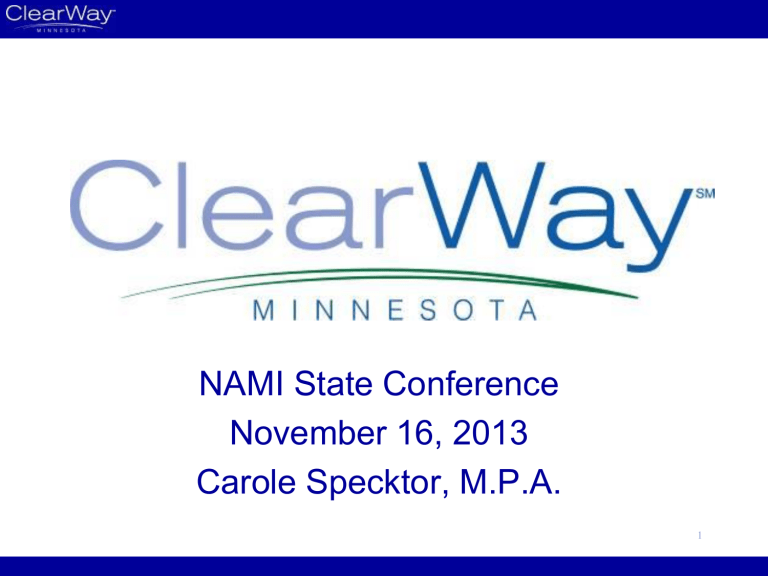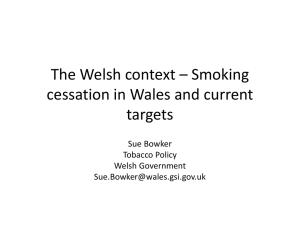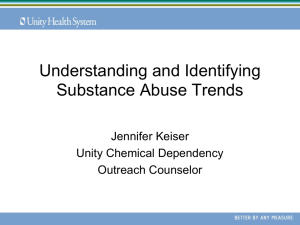Carole Specktor - NAMI Minnesota

NAMI State Conference
November 16, 2013
Carole Specktor, M.P.A.
1
Presentation Overview
• About ClearWay Minnesota SM
• Why tobacco is still a problem
• Why it is important to address tobacco use?
• Smoking and persons with mental illness
• QUITPLAN® Services
2
About ClearWay Minnesota
• Mission: Reduce the harm tobacco causes the people of
Minnesota
• Grant-making, QUITPLAN stop-smoking services and statewide outreach activities
3
ClearWay Minnesota’s Work
• Policy Changes
• Research
• Reducing Disparities
• Cessation Services
4
Media Campaigns and Outreach
5
Why is Tobacco Still a Problem?
#1 Reason:
The Tobacco Industry
6
Tobacco Industry Adapts
7
Masterful Consumer Marketing
8
Targeted Marketing
• Tobacco industry has targeted populations to increase usage and loyalty
• Examples:
– African Americans
– American Indians
– Latinos
– Persons with mental illness
– LGBT community
– Low-SES
– Youth
E-Cigarettes
• Untested and unregulated
• Not proven as safe alternative to smoking
• Not an approved cessation aid
• Often candy-flavored
• CDC study: use of e-cigarettes among middle- and high-school students more than doubled between 2011 and 2012
10
Quitting is Hard
• Nicotine is highly addictive
• Fundamental changes to the brain
• Behavioral and psychological aspects of addiction
11
Why Address Tobacco?
12
Tobacco is a Killer Problem
• Smoking is the number one cause of preventable disease and death
• 443,000 tobacco-related deaths per year nationally
• On average, smokers die 13 to 14 years earlier than nonsmokers
Smoking in Minnesota
• 625,000
Minnesota adults smoke (16%)
• Secondhand smoke exposure (2010):
‒ Nearly 46% of adults exposed
‒ 282,000 Minnesota children exposed
• Majority of Minnesota smokers want to quit
Minnesota Adult Tobacco Survey Tobacco Use in Minnesota: 1999-2010
14
4000 Chemicals in Cigarettes
Examples and where these chemicals are found:
– Acetone: nail polish remover
– Acetic Acid: hair dye
– Ammonia: household cleaner
– Arsenic: rat poison
– Butane: lighter fluid
– Cadmium: battery acid
– Carbon Monoxide: car exhaust
– Nicotine: insecticide
– Tar: pavement
15
16
Impact of Quitting
17
Smoking and Mental Illness
18
High Prevalence
• Higher prevalence imposes heavy morbidity and mortality burden
• Thirty-one percent of all cigarettes are smoked by adults with mental illness
• Why higher prevalence?
− Targeted by tobacco industry
− Biological, psychological and social factors
− To date, not commonly addressed by providers
Vital Signs: Current Cigarette Smoking Among Adults Aged >18 Years with Mental Illness – United States, 2009-2011 19
Quitting and Persons with Mental
Illness
• Can quit
• Want to quit
• Want information to help them quit
• Some factors may make it harder to quit, but . . .
• Evidence shows cessation strategies work
• Studies show that quitting smoking does not worsen psychiatric symptoms
Vital Signs: Current Cigarette Smoking Among Adults Aged >18 Years with Mental Illness – United States, 2009-2011; Tobacco
Cessation for Persons with Mental Illness or Substance Use Disorders, Center for Tobacco Cessation
20
Understanding Higher
Prevalence: Biological Factors
Persons with mental illness have unique neurobiological features that may:
– Increase tendency to use nicotine
– Make it more difficult to quit; and
– Complicate withdrawal symptoms
Smoking Cessation for Persons with Mental Illnesses: A Toolkit for Mental Health Providers
21
Understanding Higher Prevalence:
Psychological and Social Factors
• Psychological considerations:
– Smoking relieves tension, anxiety and stress
– Daily routine
• Social considerations:
– Smoke to relieve boredom
– Smoke to feel part of a group
Smoking Cessation for Persons with Mental Illnesses: A Toolkit for Mental Health Providers 22
Understanding Higher Prevalence: Myths and Barriers within Behavioral Health Care
Commonly stated reasons why mental health providers have not addressed smoking with clients:
• They can’t or don’t want to quit
• More pressing issues
• Concerns about worsening symptoms
• Lack of training
• Don’t want to take away one of patients’ few pleasures
• Shared smoke breaks build strong relationships
Triggering a Paradigm Shift in Treating Patients with Mental Health and Addictive Disorders, Wisconsin Nicotine Treatment Integration
Project (presentation, July 28 2011); Vital Signs: Current Cigarette Smoking Among Adults Aged >18 Years with Mental Illness –
United States, 2009-2011; Building the Case to support Tobacco Cessation, National Council for Behavior Health, June 28, 2013
23
Training
• Recent study found psychiatrists:
– Address tobacco less frequently than other physicians
– Reported receiving no or inadequate training on tobacco-related interventions
• Survey of Wisconsin mental health providers:
– The majority (72%) support adding nicotine dependence treatment skills to credentials
– With training, the majority (66%) are willing to provide treatment
Physician Behavior and Practice Patterns Related to Smoking Cessation, Association of American Medical Colleges ; Wisconsin Nicotine
Treatment Integration Project 24
Strategies to Reduce Smoking for
Persons with Mental Illness
• Reframe expectations of success
• Integrate tobacco as part of an approach to mental health treatment and overall wellness
• Provide mental health providers the training and tools they need to address tobacco with patients
• Utilize existing resources such as quitlines
25
26
QUITPLAN® Services
27
The Good News: Treatment Helps
• Evidence-based treatment can double or triple success
• Evidence-based treatment:
– Counseling
– FDA-approved medications
– Both
• Best outcomes with both
28
QUITPLAN Helpline Basics
• Free Services
• Serves:
– Uninsured
– Underinsured, including Medicaid Fee-for-
Service
– Live or work in Minnesota
• Phone Counseling in English and Spanish
– Partner with Asian Smokers’ Quitline
– Other languages through translation service
29
QUITPLAN Helpline Program
• Multi-call, one-on-one coaching program
• Integrated text messages
• Print materials
• Nicotine Replacement
Therapy
• Two enrollments per year
30
QUITPLAN: Mental Health
• Training for coaches
– Training for individualized services
– Substantial mental health training
– Ongoing
• Intake questions
• Monitor field and adapt approach as appropriate
31
Nicotine Replacement Therapy
• Patches, gum or lozenge
• Uninsured and underinsured
• Four weeks per enrollment*
(eight weeks per Medicaid enrollment)
• Medical screening
• Age 18 and older
• Live or work in Minnesota
*twice every12-months
32
quitplan.com
• English and
Spanish
• NRT not available through quitplan.com
• Available to all
Minnesotans, regardless of insurance status
33
Materials
• Order QUITPLAN Materials at: www.clearwaymn.org
(click “about”)
– Brochures in English and Spanish
– Smokeless tobacco brochure
– Palm card
• Mailed to you free of charge
• E-cigarette fact sheet available on website
34
36
37






